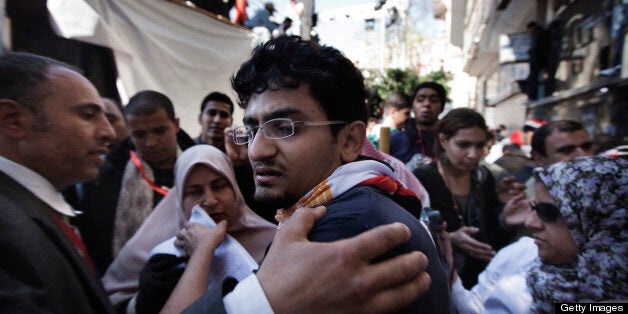
Allow me please to take you back for a moment to the beginning of 2011. Remember how surprised the world was that, in just 18 days, a leaderless grass-root uprising managed to topple the Mubarak regime that had ruled Egypt with an iron fist for 30 years?
Much has been written since then about the causes of the January 25 Revolution. But nothing has come anywhere close to what is provided by this wonderful book, Revolution 2.0: The Power of the People is Greater than the People in Power. It appeared last year and I deeply regret having waited so long to read it. Having said that, this backward-looking book did provide important insights on Egypt's current situation and what may lie ahead.
Written by the now-famous Google executive and accidental revolutionary Wael Ghonim, the book provides you with an amazing birds' eye view of the build-up to the uprising and its successful conversion into a force for democracy, social justice and respect for human rights -- or, to use the inspiring revolutionary chant, "bread, freedom and human dignity."
By his own well-written account, Ghonim was neither brilliant at school nor a great rebel. He was, however, an intensely focused and determined individual who was eager to question and did not readily take no for an answer.
At first, he grew up absorbing the culture of fear that had infiltrated virtually every aspect of Egyptian life. But, unlike millions of his countrywomen and countrymen, he had one advantage: he was very tech savvy, incredibly curious and able to combine an understanding and respect for his culture with access to insights from the outside world.
Ghonim's interest in politics and the changes that it can bring to society started early. But his real moment of consequential political awakening came a little later.
In 2010, Ghonim saw for the first time the photo of Khaled Said, a young Egyptian tortured and murdered by members of the then-State Security forces. The book describes vividly how tears came pouring out as he stared at Said's badly-disfigured face on the Internet. Awakened and shaken, he launched a Facebook page honoring the young man and seeking justice for him, as well as for many others who had suffered unduly at the hand of the Ministry of Interior.
Calling it "Kullena Khaled Said" (or We are all Khaled Said), Ghonim was taken aback initially by the popularity of his Facebook page. Somewhat timidly at first, and hesitant to venture near the lime light, he intensely worked behind the scenes to mobilize the many young Egyptians who were angry at a regime that did not respect them, and felt alienated in a country that was being run for the benefit of the privileged few.
Drawing a page from Ghandi's non-violence philosophy, the page organized a series of peaceful "Silent Stands" to protest police brutality. The movement captured the interest of the disgruntled young and activists, and it secured their loyalty by engaging them in surveys, encouraging a high level of interactions on the page, and essentially reinventing crowd sourcing and decision-making -- all of which is documented in a fascinating way in this fast-moving book.
As important, if not more, the page administered by Ghonim and Abdelrahman Mansour (who joined the page on its third day as the second admin) achieved something that many thought improbable if not impossible: Encouraging an increasing number of young Egyptian to believe that they stood a chance at regaining a claim on their country and its destiny. In the process, they started gradually overcoming multiple barriers of fear that, both explicitly and implicitly, had relegated them to just impotent and frustrated observers. No longer were they willing to accept, as Ghomin self-reflected at the time, "the fact that I'm so insignificant that my fate can be decided by a government, or State Security, or a police force."
Bolstered by the success of the popular uprising in Tunisia a few days earlier, Ghonim took the brave step of calling for a revolution on January 25 -- the spontaneous popular uprising that served as THE catalyst for the millions of Egyptians that subsequently took to the streets of cities and villages to topple the Mubarak regime in a largely-peaceful, determined and previously-unthinkable manner.
The revolution that started on January 25 was about citizens keen to overcome "torture, corruption, injustice and unemployment." They sought to hold more accountable a government that treated Egypt like a "piece of property that can be divided among a few" while the rest "sit and watch." They came from all social classes, religions and backgrounds. And most of them were demonstrating for the first time in their lives. In the process, they gave credence to the view that "Egyptians are capable of the impossible if they stand united."
As the saying goes, the rest is history -- that is before you internalize the book's unique ability to take you behind the scenes.
After readers are taken along a suspenseful buildup to January 25, Ghonim shares with us in a disarmingly humble way what he went through in prison while millions around the world watched the crowds gather in Tahrir (Liberation) Square demanding representation, freedom, dignity and justice.
Arrested on January 27, Ghonim is beaten, interrogated and psychologically tortured by State Security forces frantically trying to understand the rapidly-changing situation in the street, including the role that social media is playing. Blindfolded for most of his 12 day arrest, he emerged from prison unaware of what had transpired on the streets and in the media.
Shortly after his release, Ghonim agrees to appear on a live television show. After speaking about his motivations and aspirations for Egypt, he broke down in tears when told of fellow citizens who had died at the hands of thugs seeking to regain the streets for the Mubarak regime. He gets particularly emotional and leaves the set after being shown the picture of yet another young person "who had dreamed of change and paid for it with his life, only two months after his wedding."
Ghomin's genuine and unanticipated behavior ended up by breathing enormous life and excitement at a critical time -- when, having already secured concessions from Mubarak and achieved much more than anyone had dared imagined at first, a tiring revolutionary movement was starting to lose momentum and was facing a mounting risk of fragmentation. Energized by the frankness, humanity and vulnerability of Ghonim, the movement regained its composure, triumphantly completing the final mile.
I have read many writings on the Egyptian revolution. However, until "Revolution 2.0," none of them -- whether individually or collectively -- gave me such a feel for the heart and soul of the millions of unknown young Egyptians who stood up and delivered the unthinkable. And with this wonderful book having provided me a unique context, I found myself going back to the Internet to rewatch with greater appreciation the videos from 2011.
In the last two years, the exuberance of beneficial change has given way to the complicated reality of another difficult revolutionary transition: that of pivoting from dismantling a repressive past to building a better future. With Egypt still lacking institutions, leaders a la Nelson Mandela and political unity -- and with the economy and social contracts pressured under the weight of unemployment, poverty, inflation and deficits -- many are concerned that the energy of the revolution could now be channeled into sectarian violence.
I too am worried -- very worried -- by the stumbles of the last two years. Each of them makes the immediate future more uncertain and the subsequent recovery more challenging. Yet, having observed and studied many country transitions over the last 30 years, I do not share the pessimism and cynicism about Egypt's longer-term future.
Politically awakened and now feeling that they legitimately secured a claim on their country's future, the Egyptian youth will not stand by and see their revolution hijacked. And having learned from the slips of traditional political setups and unreformed institutions, it is just a matter of time until the experience and sophistication of Egypt's youth are translated into a new political force for economic revival, social justice and mutual respect.
Meanwhile, after the fall of the Mubarak regime, Ghonim stuck to his statements that he wanted "no public position or reward." He took a leave of absence from Google and, using the proceeds of the book, founded an NGO seeking to improve access to education.
Once again, his shrewd use of technology is breaking down walls that imprison millions of Egyptians who have fallen hostage to poor curriculums, stretched teachers and tiresome methods of teaching. And -- once more -- he is not dissuaded by arguments that the challenge is too big and too complex.
Yet again Ghonim moves forward against considerable odds. Just look at the early success he is having with "Tahrir Academy," an initiative that provides access to educational content to all Egyptians, and helps particularly the most vulnerable segments of society. Once again he is doing so in a manner that engages a growing number of people to address a common problem that was once deemed to be impenetrable and overwhelming.
